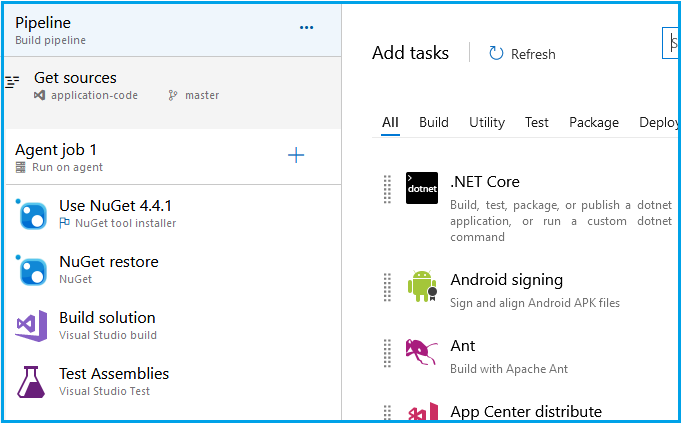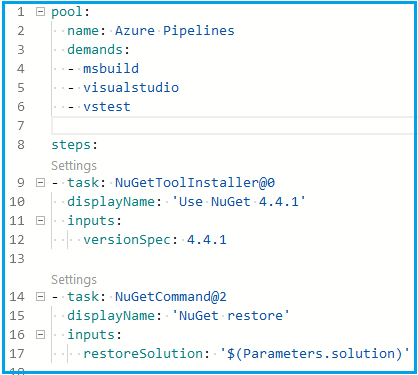When Microsoft introduced pipelines as part of their Azure DevOps cloud service offering, we received the tools to add continuous integration (CI) and continuous delivery (CD) practices to our development processes. An Azure DevOps pipeline can be created in two ways: 1) The current generally available “classic” pipeline tooling, and 2) the new multi-stage YAML pipeline feature which is currently in preview.
Classic Pipelines
Classic pipelines achieve CI through Azure DevOps build pipelines. A build pipeline executes before a developer integrates code changes into a code base. The pipeline does things like execute a build task, run the unit tests and/or run static code analysis. It then either accepts or rejects the new changes based on the outcome of these tasks.
CD is achieved through Azure DevOps release pipelines. After the build pipeline has produced a build artifact, a release pipeline will publish the artifact to various environments for manual functional testing, user experience testing and quality assurance. When testers have thoroughly tested the deployed artifacts, the release pipeline can then push the artifacts to a production environment.
As powerful as these classic CI/CD pipelines are, they do have their drawbacks. Firstly, the tooling for creating build and release pipelines does not provide a unified experience. CI pipelines provide an intuitive GUI to create and visualize the integration steps…
… and also allow you to define those very same steps in YAML:
Release pipelines also provide a GUI to create and visualize the pipeline steps. The problem is that the interface is different from that of the build pipeline and does not allow YAML definitions:
Multi-stage Pipelines
To resolve these discrepancies Microsoft introduced multi-stage pipelines. Currently in preview, these pipelines allow an engineer to define a build, release or a combined build and release pipeline as a single YAML document. Besides the obvious benefits gained through a unified development experience, there are many other good reasons to choose YAML over classic pipelines for both your builds and releases.
Since you commit YAML definitions directly to source control, you get the same benefits source control has been providing developers for decades. Here are the top 10 reasons (in no particular order) you should choose YAML for your next Azure DevOps pipeline:
1. History
Want to see what your pipeline looked like last month before you moved your connection strings to Azure KeyVault? No problem! Source control allows you to see every change ever make to your pipeline since the beginning of time.
2. Diff
Have you ever discovered an issue with your build but not known exactly when it started failing or why? Having the ability to compare the failing definition with the last known working definition can greatly reduce the recovery time.
3. Blame
Similarly, it can be useful to see who committed the bug that caused the failure and who approved the pull request. You can pull these team members into discussions on how best to fix the issue while ensuring that the original objectives are met.
4. Work Items
Having the ability to see what was changed is one thing but seeing why it was changed is another. By attaching a user story or task to each pipeline commit, you don’t need to remember the thought process that went into a particular change.
5. Rollback
If you discover that the pipeline change you committed last night caused a bad QA environment configuration, simply rollback to the last known working version. You’ll have your QA environment back up in minutes.
6. Everything As Code
Having your application, infrastructure and now build and release pipelines as code in the same source control repository gives you a complete snapshot of your system at any point in the past. By getting an older version of your repo, you can easily spin up an identical environment, execute the exact same pipelines and deploy the same code exactly as it was. This is an extremely powerful capability!
7. Reuse and Sharing
Sharing or duplicating a pipeline (or part thereof) is as simple as copy and paste. It’s just text so you can even email it to a colleague if desired.
8. Multiple Engineers
Modern CI/CD pipelines can be large and complex, and more than one engineer might modify the same YAML file, causing a conflict. Source control platforms solved this problem long ago and provide easy to use tools for merging conflicting changes. For better or worse, YAML definitions allow multiple engineers to work on the same file at the same time.
9. Peer Reviews
If application code peer reviews are important, so are pipeline peer reviews. The ability to submit a pull request before bringing in new changes allows team members to weigh in and provides an added level of assurance that the changes will perform as desired.
10. Branching
Have a crazy idea you want to try out? Create a new branch for it and trigger a pipeline execution from that branch. If your idea doesn’t pan out, simply delete the branch. No harm done.
Though still in preview, the introduction of fully text-based pipeline definitions that can be committed to source control provides benefits that cannot be achieved with classic GUI-based definitions, especially for larger organizations. Be sure to consider YAML for your next Azure DevOps pipeline implementation.









